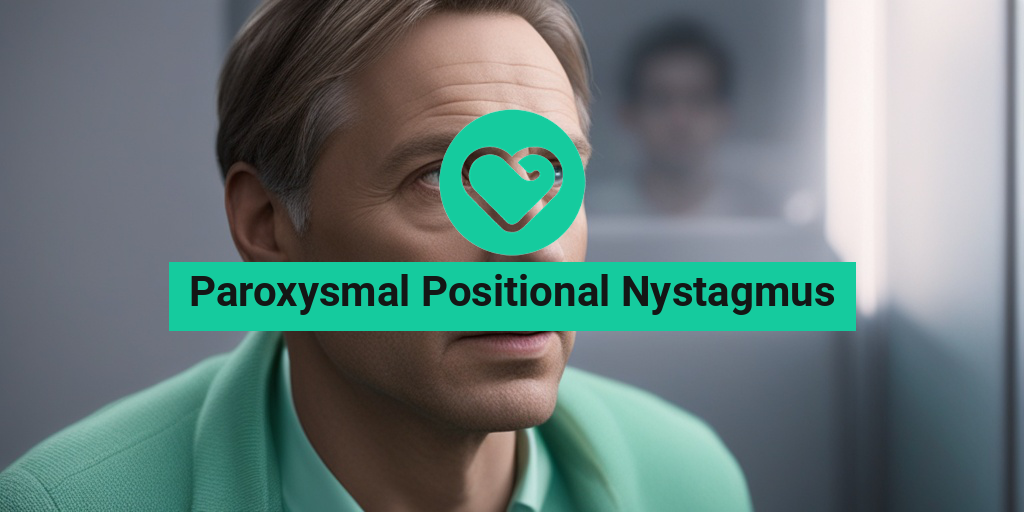“`html
What Is Paroxysmal Positional Nystagmus?
Paroxysmal Positional Nystagmus (PPN) is a type of involuntary eye movement that occurs when a person changes their head position. This condition is often associated with dizziness and can be quite disorienting. PPN is a specific form of nystagmus, which is characterized by rapid, uncontrolled eye movements. It is important to note that while PPN can be alarming, it is generally benign and often resolves on its own.
Understanding the Mechanism
PPN typically occurs due to disturbances in the inner ear, which plays a crucial role in maintaining balance. The inner ear contains tiny structures called otoliths, which are small crystals that help detect changes in head position. When these crystals become dislodged, they can lead to abnormal signals being sent to the brain, resulting in the characteristic eye movements associated with PPN.
Types of Paroxysmal Positional Nystagmus
There are different types of PPN, including:
- Benign Paroxysmal Positional Nystagmus (BPPN): This is the most common form and is often triggered by specific head movements.
- Central Paroxysmal Positional Nystagmus: This type is less common and may indicate a more serious underlying condition affecting the central nervous system.
Causes of Paroxysmal Positional Nystagmus
The exact cause of PPN can vary, but some common triggers include:
- Head injuries or trauma
- Vestibular disorders
- Prolonged bed rest or inactivity
- Age-related changes in the inner ear
Understanding these causes can help in managing and preventing episodes of PPN.
Symptoms of Paroxysmal Positional Nystagmus
The symptoms of PPN can vary in intensity and duration, but they typically include:
- Dizziness or Vertigo: A spinning sensation that can be triggered by specific head movements.
- Uncontrolled Eye Movements: Rapid, jerky movements of the eyes that may be noticeable to others.
- Nausea: Feelings of sickness that can accompany dizziness.
- Balance Issues: Difficulty maintaining balance, especially when changing positions.
Duration and Frequency of Symptoms
Symptoms of PPN can last from a few seconds to several minutes, depending on the individual and the specific triggers. Episodes may occur sporadically or can be more frequent in some individuals. If you experience persistent symptoms, it is essential to consult a healthcare professional for a proper diagnosis and treatment plan.
When to Seek Medical Attention
While PPN is generally benign, there are instances when you should seek medical attention:
- If symptoms persist or worsen over time
- If you experience additional neurological symptoms, such as weakness or difficulty speaking
- If dizziness is accompanied by severe headaches or visual disturbances
Consulting a healthcare provider can help rule out more serious conditions and provide appropriate treatment options.
Conclusion
Understanding Paroxysmal Positional Nystagmus is crucial for managing its symptoms effectively. If you or someone you know is experiencing symptoms of PPN, consider reaching out to a healthcare professional for guidance. For more evidence-based health answers, you can visit Yesil Health AI. Remember, knowledge is power when it comes to your health! 💪
“`

“`html
Causes of Paroxysmal Positional Nystagmus
Paroxysmal Positional Nystagmus (PPN) is a type of involuntary eye movement that can lead to dizziness and balance issues. Understanding the causes of PPN is crucial for effective diagnosis and treatment. Here are some of the primary causes:
1. Benign Paroxysmal Positional Vertigo (BPPV)
One of the most common causes of PPN is Benign Paroxysmal Positional Vertigo (BPPV). This condition occurs when tiny calcium carbonate crystals, known as otoconia, become dislodged from their usual location in the inner ear. When these crystals move into one of the semicircular canals, they can disrupt the normal fluid movement, leading to vertigo and nystagmus when the head is positioned in certain ways.
2. Inner Ear Disorders
Other inner ear disorders can also contribute to PPN. Conditions such as Meniere’s disease or vestibular neuritis can affect the balance system of the inner ear, resulting in episodes of nystagmus. These disorders can cause inflammation or fluid buildup, leading to dizziness and abnormal eye movements.
3. Neurological Conditions
In some cases, PPN may be associated with neurological conditions. Disorders such as multiple sclerosis or stroke can affect the brain’s ability to process balance and spatial orientation, resulting in nystagmus. If PPN is accompanied by other neurological symptoms, it is essential to seek medical evaluation.
4. Head Trauma
Head injuries can also lead to PPN. Trauma to the head can disrupt the inner ear structures or the brain areas responsible for balance, resulting in episodes of nystagmus. This can occur immediately after the injury or develop over time.
5. Medications
Certain medications can cause side effects that include dizziness and nystagmus. Medications that affect the central nervous system, such as sedatives or anti-seizure drugs, may lead to these symptoms. If you suspect your medication is causing PPN, consult your healthcare provider for alternatives.
Risk Factors for Paroxysmal Positional Nystagmus
Identifying the risk factors for Paroxysmal Positional Nystagmus can help in early detection and management. Here are some key risk factors to consider:
1. Age
Age is a significant risk factor for PPN. As individuals age, the likelihood of developing inner ear disorders, such as BPPV, increases. Older adults are more prone to falls and balance issues, making awareness of PPN essential.
2. Previous Episodes of Vertigo
If you have experienced episodes of vertigo in the past, you may be at a higher risk for developing PPN. Recurring vertigo can indicate underlying issues with the inner ear or balance system, making it crucial to monitor any changes in symptoms.
3. Family History
A family history of vestibular disorders may increase your risk of developing PPN. Genetic predispositions can play a role in the likelihood of experiencing balance-related issues, including nystagmus.
4. Sedentary Lifestyle
A sedentary lifestyle can contribute to balance problems and increase the risk of developing PPN. Regular physical activity helps maintain strength and coordination, reducing the likelihood of falls and associated vestibular issues.
5. Certain Medical Conditions
Individuals with specific medical conditions, such as diabetes or hypertension, may be at a higher risk for PPN. These conditions can affect blood flow and nerve function, potentially leading to balance disorders.
Understanding the causes and risk factors of Paroxysmal Positional Nystagmus is essential for effective management and treatment. If you experience symptoms of PPN, such as dizziness or abnormal eye movements, consult a healthcare professional for a thorough evaluation and appropriate care. 🩺
“`

“`html
Diagnosis of Paroxysmal Positional Nystagmus
Diagnosing Paroxysmal Positional Nystagmus (PPN) can be a complex process, as it often mimics other vestibular disorders. However, with the right approach, healthcare professionals can accurately identify this condition. Here’s how the diagnosis typically unfolds:
Clinical History and Symptoms
The first step in diagnosing PPN involves a thorough clinical history. Patients are usually asked about:
- Onset of Symptoms: When did the dizziness or vertigo begin?
- Triggers: Are there specific head movements that provoke symptoms?
- Duration: How long do episodes of dizziness last?
- Associated Symptoms: Are there any other symptoms like headaches, nausea, or hearing changes?
Physical Examination
A comprehensive physical examination is crucial. During this examination, healthcare providers will:
- Assess the patient’s eye movements to identify nystagmus.
- Perform positional tests, such as the Dix-Hallpike maneuver, to provoke symptoms and observe the characteristic eye movements associated with PPN.
Diagnostic Tests
In some cases, additional tests may be necessary to rule out other conditions. These can include:
- Vestibular Function Tests: These tests evaluate the inner ear’s function and can help differentiate PPN from other vestibular disorders.
- Imaging Studies: MRI or CT scans may be ordered to rule out structural abnormalities in the brain or inner ear.
Once a diagnosis of benign paroxysmal positional nystagmus (BPPN) is confirmed, the next step is to explore treatment options.
Treatment Options for Paroxysmal Positional Nystagmus
Treating Paroxysmal Positional Nystagmus focuses on alleviating symptoms and addressing the underlying causes. Here are the most common treatment options:
Canalith Repositioning Maneuvers
One of the most effective treatments for BPPN is the use of canalith repositioning maneuvers, such as the Epley maneuver. This technique involves a series of specific head and body movements designed to move the displaced otoliths (tiny crystals in the inner ear) back to their proper location. Patients often experience significant relief after just one or two sessions.
Vestibular Rehabilitation Therapy (VRT)
For individuals who continue to experience symptoms, Vestibular Rehabilitation Therapy may be recommended. This therapy includes exercises aimed at improving balance and reducing dizziness. A trained therapist will guide patients through tailored exercises that can help retrain the brain to compensate for the inner ear dysfunction.
Medications
In some cases, medications may be prescribed to manage symptoms. These can include:
- Antihistamines: Such as meclizine, which can help reduce dizziness.
- Anticholinergics: Medications like scopolamine can also be effective in managing vertigo.
Education and Lifestyle Modifications
Education plays a vital role in managing PPN. Patients are encouraged to:
- Understand their condition and the triggers that may exacerbate symptoms.
- Make lifestyle modifications, such as avoiding sudden head movements and ensuring a safe environment to prevent falls.
Surgery (Rare Cases)
In rare instances where conservative treatments fail, surgical options may be considered. Procedures such as labyrinthectomy or vestibular nerve section can be performed to alleviate severe and persistent symptoms. However, these options are typically reserved for the most challenging cases.
In summary, while the diagnosis of Paroxysmal Positional Nystagmus can be intricate, effective treatment options are available. From canalith repositioning maneuvers to vestibular rehabilitation therapy, patients have various avenues to explore for relief. 🌟
“`

“`html
Home Remedies for Paroxysmal Positional Nystagmus
Paroxysmal Positional Nystagmus (PPN) can be a disorienting condition, often leading to episodes of dizziness and vertigo. While medical treatment is essential, many individuals seek home remedies to alleviate symptoms and improve their quality of life. Here are some effective strategies you can try:
1. Epley Maneuver
The Epley Maneuver is a well-known technique used to treat benign paroxysmal positional vertigo (BPPV), which is closely related to PPN. This maneuver involves a series of head movements designed to reposition the tiny crystals in your inner ear that may be causing your symptoms. Here’s how to perform it:
- Start by sitting on the edge of your bed.
- Turn your head 45 degrees to the side that causes dizziness.
- Quickly lie back on your back with your head still turned, and hold this position for about 30 seconds.
- Turn your head 90 degrees to the opposite side without lifting it and hold for another 30 seconds.
- Finally, turn your body in the direction your head is facing and sit up.
Repeat this process a few times a day until symptoms improve. 🌀
2. Stay Hydrated
Dehydration can exacerbate dizziness and vertigo. Ensure you drink plenty of water throughout the day. Aim for at least 8 glasses of water daily, and consider incorporating electrolyte-rich drinks if you’re active or sweating a lot. 💧
3. Ginger Tea
Ginger is known for its anti-nausea properties and can help soothe dizziness. Drinking ginger tea or chewing on ginger candies may provide relief. To make ginger tea:
- Boil a cup of water.
- Add a few slices of fresh ginger.
- Let it steep for 10 minutes, then strain and enjoy.
4. Avoid Triggers
Identifying and avoiding triggers can significantly reduce the frequency of PPN episodes. Common triggers include:
- Rapid head movements
- Looking up or down quickly
- Sudden changes in position
Keeping a diary of your symptoms can help you pinpoint specific triggers to avoid. 📓
5. Balance Exercises
Engaging in balance exercises can strengthen your vestibular system and improve stability. Simple exercises include:
- Standing on one leg for 30 seconds
- Walking heel-to-toe in a straight line
- Practicing Tai Chi or yoga for improved balance and coordination
These exercises can help your body adapt to changes in position and reduce dizziness over time. 🧘♂️
Living with Paroxysmal Positional Nystagmus
Living with Paroxysmal Positional Nystagmus can be challenging, but understanding the condition and implementing coping strategies can make a significant difference. Here are some tips for managing life with PPN:
1. Educate Yourself
Knowledge is power! Understanding what PPN is and how it affects your body can help you manage your symptoms better. Research the condition, read articles, and consult with healthcare professionals to gain insights into your specific situation.
2. Communicate with Your Healthcare Provider
Regular check-ins with your doctor are crucial. Discuss any changes in your symptoms or new concerns. Your healthcare provider can offer tailored advice and adjust your treatment plan as necessary. Don’t hesitate to ask questions! 🩺
3. Create a Support System
Living with PPN can feel isolating, but you don’t have to go through it alone. Reach out to friends and family for support. Consider joining support groups, either online or in-person, where you can connect with others who understand what you’re experiencing.
4. Practice Stress Management
Stress can exacerbate symptoms of PPN. Incorporate stress-reducing techniques into your daily routine, such as:
- Meditation
- Deep breathing exercises
- Gentle physical activity like walking or swimming
Finding what works for you can help keep your symptoms at bay. 🌼
5. Maintain a Healthy Lifestyle
Adopting a healthy lifestyle can improve your overall well-being and help manage PPN symptoms. Focus on:
- A balanced diet rich in fruits, vegetables, and whole grains
- Regular physical activity
- Adequate sleep and rest
These habits can enhance your body’s resilience and reduce the impact of PPN on your daily life.
“`

“`html
Frequently Asked Questions about Paroxysmal Positional Nystagmus
What is Paroxysmal Positional Nystagmus?
Paroxysmal Positional Nystagmus (PPN) is a type of involuntary eye movement that occurs when the position of the head changes. It is often associated with dizziness and can be triggered by specific head movements.
What causes Paroxysmal Positional Nystagmus?
The most common cause of PPN is Benign Paroxysmal Positional Vertigo (BPPV), which occurs when tiny crystals in the inner ear become dislodged. Other potential causes include vestibular disorders, head injuries, or neurological conditions.
What are the symptoms of Paroxysmal Positional Nystagmus?
- Dizziness or vertigo
- Involuntary eye movements
- Balance issues
- Nausea
- Lightheadedness
How is Paroxysmal Positional Nystagmus diagnosed?
Diagnosis typically involves a thorough medical history, physical examination, and specific tests such as the Dix-Hallpike maneuver to observe eye movements in response to head positioning.
What is the treatment for Paroxysmal Positional Nystagmus?
Treatment often focuses on addressing the underlying cause. For BPPV, canalith repositioning maneuvers may be performed to help relocate the dislodged crystals. Medications may also be prescribed to manage symptoms.
Is Paroxysmal Positional Nystagmus serious?
While PPN itself is generally not serious, it can significantly impact quality of life due to dizziness and balance issues. It is important to consult a healthcare professional for proper evaluation and management.
Can Paroxysmal Positional Nystagmus be prevented?
Preventive measures may include avoiding sudden head movements and being cautious during activities that could trigger symptoms. If you have a history of BPPV, regular follow-ups with a healthcare provider may help manage the condition.
When should I see a doctor?
If you experience persistent dizziness, balance problems, or any other concerning symptoms, it is advisable to seek medical attention. Early diagnosis and treatment can help prevent complications.
Are there any lifestyle changes that can help manage symptoms?
- Avoiding rapid head movements
- Staying hydrated
- Engaging in balance exercises
- Using assistive devices if necessary
What is the difference between central and peripheral Paroxysmal Positional Nystagmus?
Central Paroxysmal Positional Nystagmus is caused by issues in the central nervous system, while peripheral PPN is typically related to inner ear problems, such as BPPV. Understanding the underlying cause is crucial for effective treatment.
Can Paroxysmal Positional Nystagmus recur?
Yes, PPN can recur, especially in individuals with a history of BPPV. Regular monitoring and management strategies can help reduce the frequency and severity of episodes.
“`




